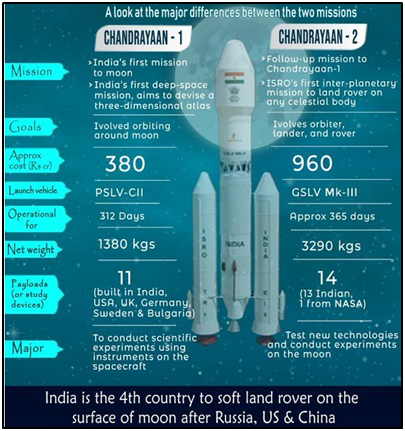Why in News?
- The Indian Space Research Organisation (ISRO) plans to retain the names of the Chandrayaan-2 lander (Vikram) and rover (Pragyan) for their Chandrayaan-3 equivalents as well.
- Following Chandrayaan-2, where a last-minute glitch led to the failure of the lander's (Vikram) soft landing attempt after a successful orbital insertion, another lunar mission (Chandrayaan-3) for demonstrating soft landing was proposed.
What’s in Today’s Article?
- The Chandrayaan-3 Mission
- Chandrayaan-3 Payloads
- How will the Mission be Implemented?
The Chandrayaan-3 Mission:
- Chandrayaan-3 ("mooncraft") is a planned 3rd lunar exploration mission by the ISRO to demonstrate end-to-end capability in -
- Safe landing (through the lander Vikram - after Vikram Sarabhai, the father of the Indian space programme) and
- Roving (through the rover Pragyan) on the lunar surface.
- Unlike Chandrayaan-2, it will not have an orbiter and its propulsion module will behave like a communications relay satellite.
- Chandrayaan-3 interplanetary mission has three major modules: the Propulsion module, Lander module, and Rover.
- ISRO plans to launch the third moon mission in mid-July aboard the LVM3 (formerly GSLV Mk-III) rocket from Sriharikota.
Chandrayaan-3 Payloads:
- The propulsion module: It has Spectro-polarimetry of Habitable Planet Earth (SHAPE) payload to study the spectral and polarimetric measurements of Earth from lunar orbit.
- Lander payloads: It will have 4 payloads -
- Radio Anatomy of Moon Bound Hypersensitive ionosphere and Atmosphere (RAMBHA) to study the temporal evolution of electron density in the Lunar ionosphere.
- Chandra’s Surface Thermophysical Experiment (ChaSTE) to measure the thermal conductivity and temperature;
- Instrument for Lunar Seismic Activity (ILSA) for measuring the seismicity around the landing site;
- Langmuir Probe (LP) to estimate the plasma density and its variations.
- Rover payloads: Alpha Particle X-ray Spectrometer (APXS) and Laser Induced Breakdown Spectroscope (LIBS) for deriving the elemental composition in the vicinity of the landing site.

How will the Mission be Implemented?
- A propulsion module will carry the lander-rover configuration to a 100-km lunar orbit.
- Once the ‘Vikram’ lander module makes it safely to the moon, it will deploy ‘Pragyan’.
- Pragyan will carry out in-situ chemical analysis of the lunar surface during the course of its mobility.










